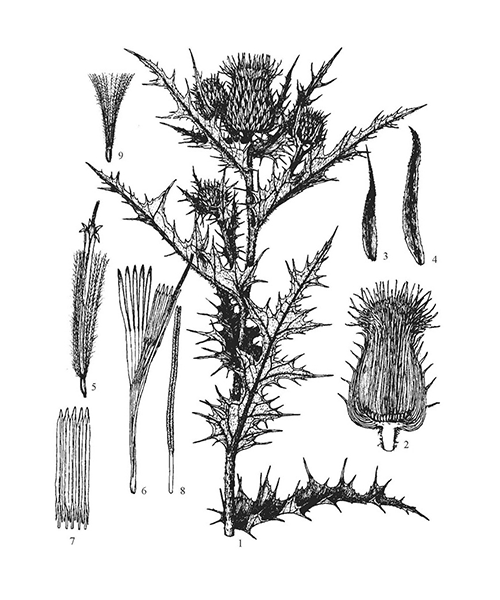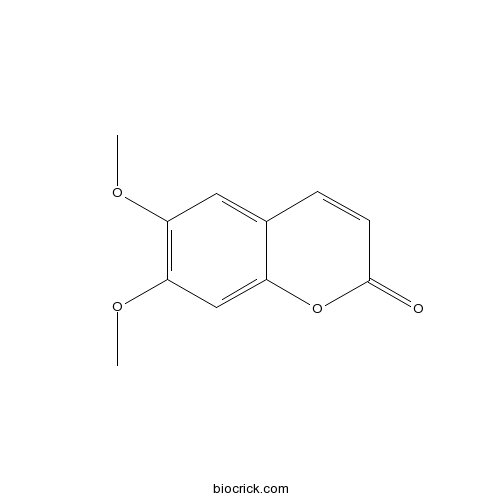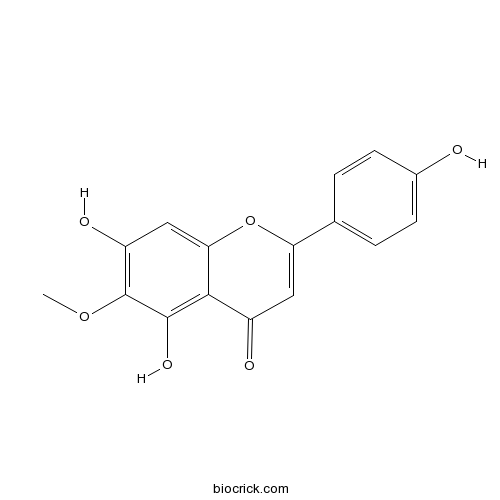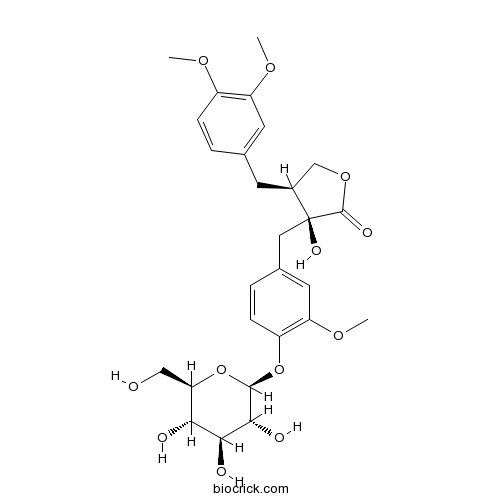Cirsium japonicum
Cirsium japonicum
1. The products in our compound library are selected from thousands of unique natural products; 2. It has the characteristics of diverse structure, diverse sources and wide coverage of activities; 3. Provide information on the activity of products from major journals, patents and research reports around the world, providing theoretical direction and research basis for further research and screening; 4. Free combination according to the type, source, target and disease of natural product; 5. The compound powder is placed in a covered tube and then discharged into a 10 x 10 cryostat; 6. Transport in ice pack or dry ice pack. Please store it at -20 °C as soon as possible after receiving the product, and use it as soon as possible after opening.

Natural products/compounds from Cirsium japonicum
- Cat.No. Product Name CAS Number COA
-
BCN6059
Syringin118-34-3
Instructions

-
BCN6088
Scoparone120-08-1
Instructions

-
BCN6250
Hispidulin1447-88-7
Instructions

-
BCN1217
Pectolinarin28978-02-1
Instructions

-
BCN2738
Tracheloside33464-71-0
Instructions

-
BCN5554
Linarin480-36-4
Instructions

-
BCN5560
Acacetin480-44-4
Instructions

-
BCN5957
Podophyllotoxin518-28-5
Instructions

-
BCN5813
Pectolinarigenin520-12-7
Instructions

-
BCN2356
Diosmetin520-34-3
Instructions

-
BCN4470
Scopoletin92-61-5
Instructions

Luteolin Ameliorates Cognitive Impairments by Suppressing the Expression of Inflammatory Cytokines and Enhancing Synapse-Associated Proteins GAP-43 and SYN Levels in Streptozotocin-Induced Diabetic Rats.[Pubmed: 30088237]
Luteolin, a flavonoid isolated from Cirsium japonicum, has antioxidant, anti-inflammatory and neuroprotective activities. Our previous studies brought a prospect that luteolin benefited diabetic rats with cognitive impairments. In this study, we examined whether luteolin could suppress the inflammatory cytokines, thus increasing synapse-associated proteins in streptozotocin (STZ)-induced diabetes in rat models. The model rats underwent luteolin treatment for 8 consecutive weeks, followed by assessment of cognitive performances with MWM test. Nissl staining was employed to assess the neuropathological changes in the hippocampus and the effects of luteolin on diabetic rats. With animals sacrificed, expressions of inflammatory cytokines including interleukin-1β (IL-1β) and tumor necrosis factor-α (TNF-α) and synapse-associated proteins including growth-associated protein-43 (GAP-43) and synaptophysin (SYN) were determined. The results affirmed improvement of behavioral performances in the MWM test, downexpression of glycation end products (AGEs) in the plasma and the receptor for advanced glycation end products in the hippocampus, inhibition of IL-1β and TNF-α in both the hippocampus and plasma in diabetic rats. Furthermore, luteolin treatment upregulated the expressions of GAP-43 and SYN in the hippocampus. Thus, luteolin could ameliorate the cognitive dysfunctions in STZ-induced diabetic rat model.
Cirsimarin, a flavone glucoside from the aerial part of Cirsium japonicum var. ussuriense (Regel) Kitam. ex Ohwi, suppresses the JAK/STAT and IRF-3 signaling pathway in LPS-stimulated RAW 264.7 macrophages.[Pubmed: 30053449]
None
Ultrahigh-performance liquid chromatography coupled with triple quadrupole and time-of-flight mass spectrometry for the screening and identification of the main flavonoids and their metabolites in rats after oral administration of Cirsium japonicum DC. extract.[Pubmed: 29781217]
Cirsium japonicum DC., a traditional Chinese medicine, has been shown to have anti-haemorrhagic and anti-tumour effects. Pharmacological studies have demonstrated that this curative effect may be related to flavonoids. The present work aimed to screen and identify the main flavonoids and their corresponding metabolites in rats after oral administration of Cirsium japonicum DC. extract.
Beneficial effects of Cirsium japonicum var. maackii on menopausal symptoms in ovariectomized rats.[Pubmed: 29632938]
In women, menopause refers to a series of physiological and mental symptoms of distress that result from a decrease in 17β-estradiol. In addition to the loss of fertility, the symptoms include facial flushing, depression, osteoporosis, sexual dysfunction, and genitourinary atrophy. Cirsium japonicum var. maackii is a perennial herbaceous species found in the mountains and fields of Korea, China, and Japan. The medicinal uses of C. japonicum include antioxidant, antidiabetic, antitumor, antifungal, and anti-inflammatory activities. We investigated the effect of C. japonicum extract in a rat model of menopause that exhibited rapid estrogen decline induced by ovariectomy (OVX rats). The rats were treated with C. japonicum extract for 10 weeks and the following parameters were measured: food intake, feed efficiency, body weight, total cholesterol, triglyceride, LDL-cholesterol, HDL-cholesterol, liver weight, 17β-estradiol, uterus weight, AST, ALT, bone mineral density (BMD), bone alkaline phosphatase, calcitonin, and osteocalcin. In OVX rats, the administration of 50 and 100 mg kg-1C. japonicum extract significantly decreased body weight, total cholesterol, triglyceride, HDL-cholesterol, and LDL-cholesterol and significantly increased 17β-estradiol and BMD. During the light/dark box test, the C. japonicum treatment group (100 mg kg-1) spent more time in the light chamber than in the dark area, which was reflective of their diurnal nature. Using a molecular docking simulation, we predicted the plausible binding mode of the active compounds of C. japonicum with the ligand binding domain of estrogen receptor (ER)-α and ER-β. These results showed that C. japonicum extract can treat the symptoms before and after the menopause.
In renal hypertension, Cirsium japonicum strengthens cardiac function via the intermedin/nitric oxide pathway.[Pubmed: 29525674]
Cirsium japonicum, a constituent of traditional Chinese medicine, has been shown to exert inflammatory effects as well as to improve the circulation and thus to counteract hematologic stasis. Studies have demonstrated that intermedin (IMD) has protective effects on hypertension in rats by regulating the Ang/NO metabolic pathway. In this study, we investigated whether by regulating the expression of IMD, Cirsium japonicum could improve cardiac function in rats with 2k1c-induced renal hypertension. Renal hypertension was induced in Sprague-Dawley rats by occluding the renal artery. The rats were maintained on a normal diet and randomly divided into four groups: sham, 2k1c, 2k1c with Cirsium japonicum (1.8 g/kg per day) and 2k1c with IMD (n = 10 in each group). Cardiac function, plasma angiotensin II (Ang II), IMD, serum nitric oxide (NO) and nitric oxide synthase (NOS), as well as the expression of IMD and adrenomedullin (ADM) in the aorta and left ventricle were analyzed. Administration of Cirsium japonicum or IMD significantly strengthened cardiac function in 2k1c-induced rats, increased serum NO and NOS levels, reduced plasma Ang II, and upregulated IMD expression in the aorta and left ventricle. These results demonstrate that Cirsium japonicum has cardioprotective effects on 2k1c-induced renal hypertension in rats via the IMD/NO pathway.
First total synthesis of a new phenylpropanoid glycoside: natural cytotoxic compound from Cirsium japonicum.[Pubmed: 28948834]
Phenylpropanoid glycoside compound 1, the natural anti-tumor compound isolated from the erial parts of Cirsium japonicum, was first totally synthesized using easily available materials in short, convenient route with overall yield of 13.9%.
Beneficial effects of a medicinal herb, Cirsium japonicum var. maackii, extract and its major component, cirsimaritin on breast cancer metastasis in MDA-MB-231 breast cancer cells.[Pubmed: 28784292]
The biological activities of the ethanol extract from Cirsium japonicum var. maackii (ICF-1) and its major component, polyphenol cirsimaritin, were investigated as part of the search for possible alternative drugs for breast cancer. Three in vitro cell-based assays were used: the cell proliferation assay, tube-formation assay, and Western blot analysis. Both the ICF-1 extract and cirsimaritin inhibited the viability of HUVECs in a dose-dependent manner. The inhibition achieved was 36.89% at a level of 200μg/ml by the ICF-1 extract and 62.04% at a level of 100μM by cirsimaritin. The ICF-1 extract and cirsimaritin reduced tube formation by 12.69% at level of 25μg/ml and 32.18% at the levels of 6.25μM, respectively. Cirsimaritin inhibited angiogenesis by downregulation of VEGF, p-Akt and p-ERK in MDA-MB-231 cells, suggesting that cirsimaritin is potentially useful as an anti-metastatic agent. The present study demonstrated that Cirsium japonicum extract and its active component cirsimaritin is an excellent candidate as an alternative anti-breast cancer drug.
Protective effects of flavonoids isolated from Korean milk thistle Cirsium japonicum var. maackii (Maxim.) Matsum on tert-butyl hydroperoxide-induced hepatotoxicity in HepG2 cells.[Pubmed: 28735729]
Milk thistle leaves and flowers have been traditionally used as herbal remedy to alleviate liver diseases for decades. Korean milk thistle, Cirsium japonicum var. maackii (Maxim.) Matsum has been employed in traditional folk medicine as diuretic, antiphlogistic, hemostatic, and detoxifying agents.


